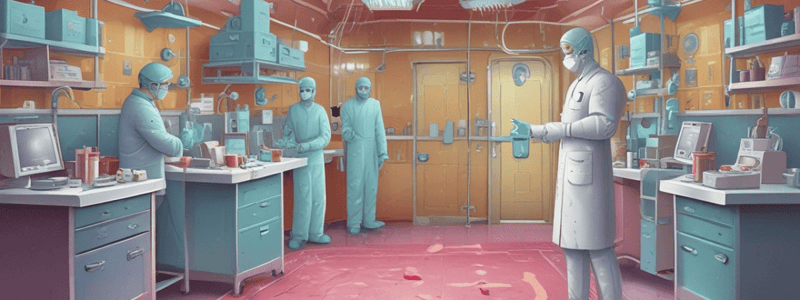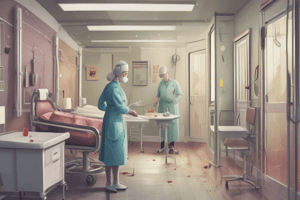Podcast
Questions and Answers
When should a patient be swabbed for MRSA or VRE?
When should a patient be swabbed for MRSA or VRE?
- If they meet certain criteria or come into contact with another patient who has it (correct)
- If they have a fever above 103°F
- Only when they are discharged from the hospital
- If they have a history of pneumonia
How is the MRSA swab collected?
How is the MRSA swab collected?
- By rolling the swab in the beginning of both sides of the nose (correct)
- By collecting a sample from a bowel movement
- By gently dipping the swab into the stoma of a patient with a colostomy
- By inserting the swab into the patient's ear
What is the purpose of moistening the cotton tip with the gel?
What is the purpose of moistening the cotton tip with the gel?
- To help the swab collect a sample (correct)
- To make the swab more flexible
- To disinfect the swab
- To label the swab
What should be visible on the VRE swab?
What should be visible on the VRE swab?
Why should the lab be notified when the swab is sent?
Why should the lab be notified when the swab is sent?
What is the purpose of labeling the swab with the patient's name and the type of swab?
What is the purpose of labeling the swab with the patient's name and the type of swab?
What is the primary purpose of collecting a wound specimen for culture and sensitivity?
What is the primary purpose of collecting a wound specimen for culture and sensitivity?
Why should the wound be cleansed with normal saline prior to collecting a swab?
Why should the wound be cleansed with normal saline prior to collecting a swab?
What is the recommended technique for collecting a swab for aerobic culture?
What is the recommended technique for collecting a swab for aerobic culture?
What is the purpose of collecting a nasal or throat swab in patients with symptoms of respiratory or sinus infection?
What is the purpose of collecting a nasal or throat swab in patients with symptoms of respiratory or sinus infection?
Who is responsible for collecting specimens and sharing the results with the interprofessional team?
Who is responsible for collecting specimens and sharing the results with the interprofessional team?
Why should culture swabs ideally be collected before a patient begins taking antibiotics?
Why should culture swabs ideally be collected before a patient begins taking antibiotics?
What is the purpose of laboratory test results in patient care?
What is the purpose of laboratory test results in patient care?
How is the anaerobic culture collected?
How is the anaerobic culture collected?
Flashcards are hidden until you start studying
Study Notes
Wound Specimen Collection
- A wound specimen for culture and sensitivity (C&S) is necessary to identify the organism present in the wound and determine the appropriate medication.
- A swab must be collected from fresh exudate and the wound should be cleansed with normal saline prior to collection to avoid contamination.
- For aerobic culture, the swab should be rolled over a 1cm x 1cm area of viable tissue in the center of the wound for at least 5 seconds.
- For anaerobic culture, the swab should be inserted deeply into the body cavity and rotated gently or inserted into the wound and aspirated 5-10mls of exudate.
Laboratory Test Results
- Laboratory test results aid in diagnosis, provide information about the stage and activity of a disease process, and measure a patient's response to therapy.
- Nurses are accountable for collecting specimens, monitoring patient outcomes, and ensuring timely sharing of test results with the interprofessional team.
Nasal and Throat Swabs
- Patients with symptoms of respiratory or sinus infection may require a nasal or throat swab for diagnostic purposes, which requires a physician's order.
- Ideally, culture swabs should be collected before a patient begins taking antibiotics; if already taking antibiotics, the lab should be notified.
MRSA and VRE Swabs
- Patients may need to be swabbed for MRSA or VRE on admission if they meet criteria or if they come into contact with another patient who has it.
- MRSA swab is taken from the nose, and VRE swab is taken from the rectum or from a stool sample.
- The swab should be labeled with the patient's name and the specific location (e.g. "Nose/Nasal Swab" or "Stool or Rectal swab").
Studying That Suits You
Use AI to generate personalized quizzes and flashcards to suit your learning preferences.



